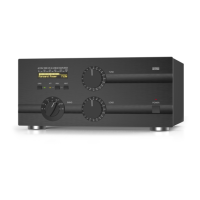Tuning to the left of the center would lead to the opposite: less gain and more power attainable. Of course,
this requires more drive power, more plate current, and more plate heat, which shortens tube's-expected
life, as its cathode would be faster exhausted.
Off-center tuning may also be used to compensate for line (mains) voltage variations in order to maintain
tube efficiency. In that case, tune to the right when mains is higher, or tune to the left if it's lower than the
nominal voltage. However, where there is more than a 10% difference from the nominal line (mains)
voltage, the voltage selector inside the amplifier should be changed (see Section 2.2 Line Voltage Selection).
4.4. ON LINE Information Screens and Control Functions
a) Besides the Warming Up and TRI (see Sections 4.1 Turning ON and OFF, 4.2 Changing OPERATE
and STANDBY Modes, 4.3 Tuning), you have 12 more Information screens available. They are
as follows:
• Forward Power
• Reflected Power
• Output Power (difference between Forward and Reflected)
• Antenna VSWR
• Drive RF Power
• RF Power Gain
• Plate Current
• High Voltage
• Plate RF Peak
• Screen Current
• DC Power Input (product of plate current and high voltage)
• Exhaust Air Temperature (Celsius and Fahrenheit scales).
You can use them to monitor the technical state of the amplifier and associated parameters in digital form.
Selection is made by the PREV and NEXT buttons. You may change them in a closed loop, while the
amplifier is used and controlled in OPERATE and STANDBY modes, changes transmit and receive, without
any influence by the measurement process.
b) You can control AUTO-OPERATE feature selection also while ON LINE. The method is the
same as it is described for OFF LINE (see Sections 5.1 Display Contrast and Backlighting Control
and 5.2 Auto-Operate Enabling and Disabling).

